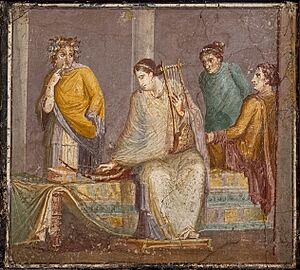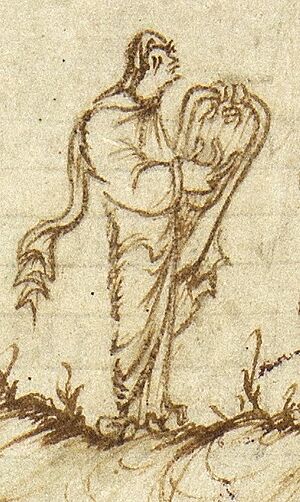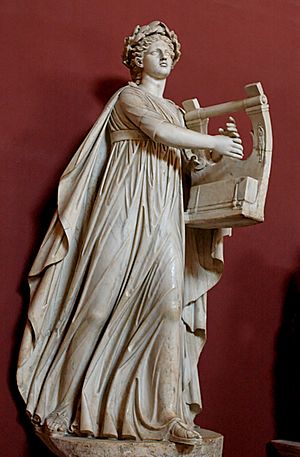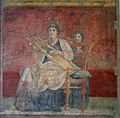Kithara facts for kids

The kithara (pronounced kith-AH-ra) was an ancient Greek musical instrument. It was like a fancy, professional version of the lyre, which was a simpler instrument often used to teach music to beginners. Unlike the lyre, the kithara was mainly played by expert musicians called kitharodes. Today, the Greek word kithara means "guitar", and the word "guitar" actually comes from "kithara"!
Contents
What is a Kithara?
The kithara was a type of yoke lutes instrument, meaning it had a sound box and two arms with a crossbar connecting them. It usually had seven strings. It was a very important instrument in ancient Greece and Rome.
Where Did the Kithara Come From?
The kithara developed from older stringed instruments used by the Minoans and Mycenaeans during the Bronze Age. Some experts believe it might be connected to similar instruments from ancient Anatolia (which is modern-day Turkey).
How Was the Kithara Used?
While the basic lyre was often used in schools to teach boys music, the kithara was for skilled performers. It was known for being hard to play well. Kitharas were used to accompany dancing, epic poems, songs, and odes. Musicians also played them alone at parties, banquets, and even in music competitions.
The kithara was played by strumming its strings with a stiff plectrum (a pick) usually made of dried leather. The musician would hold the plectrum in their right hand. They would use the straight fingers of their left hand to stop any strings they didn't want to sound.
How Was a Kithara Built?
The kithara had a deep, wooden sounding box. This box was made of two flat or slightly curved wooden pieces, joined together by sides. The strings were tied at the top to a crossbar or to rings on the bar. At the bottom, the strings were fastened to a tail-piece after going over a flat bridge. Sometimes, the tail-piece and bridge were combined into one part.
Most pictures from ancient times show kitharas with seven strings. Ancient writers also agreed with this. However, they sometimes mentioned that very skilled kithara players might use more than seven strings.
Apollo and the Kithara
The kithara is often said to have been invented by Apollo, the Greek god of music. Apollo is frequently shown playing a kithara instead of a lyre, often dressed in the formal robes of a kithara player. The name Kitharoidos (or Citharoedus) is an epithet (a descriptive name) given to Apollo. It means "lyre-singer" or "one who sings to the lyre."
An Apollo Citharoedus is a type of statue or image of Apollo holding a kithara. A famous example is a huge marble statue from the 2nd century CE, found in the Vatican Museums.
Famous Kithara Players
- Phrynnis of Lesbos: Ancient texts say that Phrynnis was the first person to play the kithara in Athens. He even won a prize at the Panathenaea festival. He might have used a newer version of the instrument with 12 strings.
Other Instruments Called "Cithara"

During the Middle Ages, the word cythara was sometimes used more generally for different stringed instruments. This included lyres and even instruments similar to a lute. People in the Middle Ages still remembered the original Greek kithara and how it could deeply affect people's feelings.
Images for kids
-
Alcaeus of Mytilene playing a kithara while Sappho listens. This is from a painting by Lawrence Alma-Tadema.
See also
- Ancient Greece
- Ancient Greek music
- Ancient Rome
- Barbiton
- Cythara
- Gittern, an instrument whose name comes from Kithara
- Guitar
- Harp
- Kinnor
- Kitharode
- Lyre
- Phorminx
- Pandura
- Sitar
- Zither












